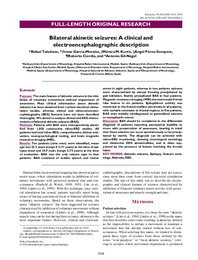Por favor, use este identificador para citar o enlazar este ítem:
https://hdl.handle.net/11000/30745
Bilateral akinetic seizures: A clinical and electroencephalographic description
Título :
Bilateral akinetic seizures: A clinical and electroencephalographic description |
Autor :
Toledano, Rafael
García Morales, Irene 
Kurtis, Monica 
Pérez-Sempere, Ángel 
Ciordia, Roberto
Gil-Nagel, Antonio |
Editor :
The International League Against Epilepsy |
Departamento:
Departamentos de la UMH::Medicina Clínica |
Fecha de publicación:
2010 |
URI :
https://hdl.handle.net/11000/30745 |
Resumen :
Purpose: The main feature of akinetic seizures is the inhibition of voluntary movements without impairment of awareness. Most clinical information about akinetic seizures has been obtained from cortical electrical stimulation studies, whereas clinical and video–electroencephalography (EEG) features have not been described thoroughly. Weaimed to analyze clinical and EEG characteristics of bilateral akinetic seizures (BAS).Methods: Patients with BAS were retrospectively identified from 1,858 consecutive video-EEG studies. All patients had ictal video-EEG, comprehensive clinical evaluation, neuropsychological testing, and brain magnetic resonance imaging (MRI).Results: Ten patients (nine men) were identified; mean age was 22.5 years (range 0.3–71 years) at the time of epilepsy onset and 34.9 years (range 5–73 years) at the time of evaluation. BAS was the only seizure type in four patients. BAS consisted of sudden speech and motor arrest in eight patients, whereas in two patients seizures were characterized by abrupt freezing precipitated by gait initiation. Startle precipitated BAS in four patients.
Magnetic resonance imaging (MRI) showed mesial frontal lobe lesions in six patients. Epileptiform activity was restricted to the frontal midline electrodes in all patients,
with variable extension to frontal regions. In five patients, BAS were initially misdiagnosed as generalized seizures or nonepileptic events. Discussion: BAS should be considered in the differential diagnosis of patients reporting paroxysmal inability to move with preservation of awareness, bearing in mind that these seizures can occur spontaneously or be precipitated by startle. The diagnosis can be achieved with video-EEG monitoring, showing stereotyped semiology and distinctive EEG abnormalities, and is often supported
by the presence of lesions involving the frontal lobes.
|
Palabras clave/Materias:
Akinetic seizures
Epilepsy
Seizure semiology
Akinesia
EEG |
Tipo documento :
application/pdf |
Derechos de acceso:
info:eu-repo/semantics/openAccess |
DOI :
https://doi.org/10.1111/j.1528-1167.2010.02662.x |
Aparece en las colecciones:
Artículos Medicina Clínica
|
 La licencia se describe como: Atribución-NonComercial-NoDerivada 4.0 Internacional.
La licencia se describe como: Atribución-NonComercial-NoDerivada 4.0 Internacional.
 La licencia se describe como: Atribución-NonComercial-NoDerivada 4.0 Internacional.
La licencia se describe como: Atribución-NonComercial-NoDerivada 4.0 Internacional.
.png)
